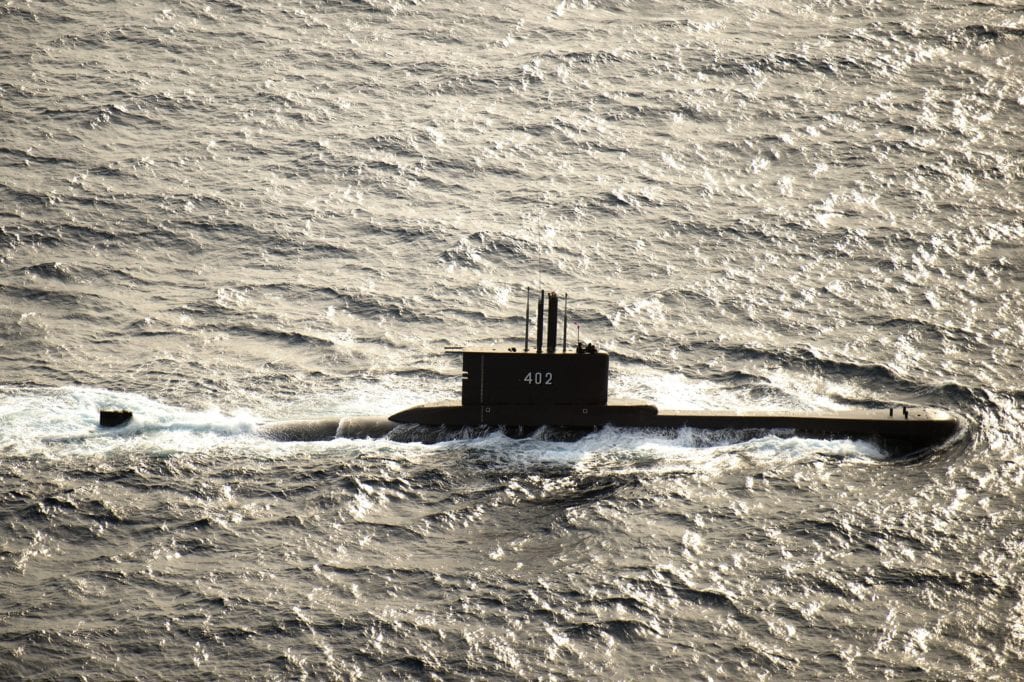
The Indonesian Navy has confirmed that one of its submarines, KRI Nanggala (402), and its crew of 53, is missing.
Reports quoting Indonesian defense officials say KRI Nanggala was participating in scheduled naval exercises about 60 miles north of the island of Bali when it submerged in waters about 2,300 feet deep. Nanggala had requested and received clearance to dive to conduct a live-torpedo firing drill. When communications were lost, the navy immediately commenced a search with ships and aircraft.
International media quoted Adm. Yudo Margono, the chief of staff of the Tentara Nasional Indonesia-Angkatan Laut (TNI-AL), saying that Nanggala had fired two torpedoes during the exercise. He said the crew had enough oxygen to support the crew for 72 hours.
Tentara Nasional Indonesia-Angkatan Laut (TNI-AL), which translates to “Indonesian National Military-Naval Force,” commissioned ships have the prefix KRI, which means Kapal Republik Indonesia or “Republic of Indonesia Ship.”
“It is true that the KRI Nanggala-402 lost contact since early this morning around 3:00 a.m. [Wednesday local time],” said 1st Adm. Julius Widjojono.
A TNI statement said: “It is possible that during static diving, a blackout occurred so control was lost and emergency procedures cannot be carried out and the ship falls to a depth of 600-700 meters (about 2,000 to 2,300 feet).”
“We know the area but it’s quite deep,” Widjojono told reporters.
However, Widjojono told the independent Indonesian TV network, KompasTV, that the diesel-electric submarine was built to sustain pressure at a maximum depth of around 250 to 500 meters (820 to 1,640 feet). “Anything more than that can be pretty fatal,” he said.
Searchers noted an oil slick near where Nanggala submerged, which may have come from the missing submarine.
Indonesia has requested support from several nations, including Singapore, Australia and Malaysia. The United States, Germany, France, Turkey, India and have also offered to help search for the missing submarine.
“It’s very distressing for families and particularly for the Indonesian navy,” said Australian Foreign Minister Marise Payne. “We have indicated that we will help in any way we can. We operate very different submarines from this one, but the Australian Defence Force and our Australian Defence organisation will work with defence operations in Indonesia to determine what we may be able to do. We will go to the support of our neighbour in any way we can.”
Singapore has dispatched M/V Swift Rescue, a commercial ship under charter to the Republic of Singapore Navy carrying sophisticated submarine rescue equipment, including a Deep-Submergence Rescue Vessel (DSRV), hyperbaric chamber and a medical team.
The TNI operates five submarines. Nanggala is one of two 1,300-ton,195-foot Cakra-class boats were built in Germany by Howaldtswerke, commissioned in the Indonesian Navy in 1981. The two Type 209 submarines have undergone periodic refits.
Indonesia has three newer Type 209 submarines from South Korea, with the first being commissioned in 2017. The newest, KTI Alugoro, built at DSME in South Korea and the government-owned PT PAL in Indonesia, was commissioned last month on March 21. Three more boats are on order, to be completed at PT PAL.
The International Submarine Escape and Rescue Liaison Office (ISMERLO) sent an alert stating that it had been notified of the missing submarine and was standing by to support any response.
ISMERLO was established in 2003 by NATO and the Submarine Escape and Rescue Working Group to coordinate international submarine search and rescue operations.
ISMERLO’s international team of submarine escape and rescue are based at COMSUBNATO, part of the NATO Allied Maritime Command at Northwood, U.K., and on call 24/7/365.
“We have a wide variety of open communications capabilities to respond to a crisis,” said Italian Navy Cmdr. Gennaro Vitagliano, head of the ISMRERLO Branch at COMSUBNATO. “We are free to talk to everybody, because we are talking about saving lives at sea.”
Vitagliano said there are 41 member nations who operate submarines, including Indonesia. The only two nations that have submarines and are not members of ISMERLO are Iran and North Korea. “The rest of the world is fully involved with ISMERLO. Each nation has their points of contact and they are always accessible. We are a worldwide network to save lives at sea. We train and operate to a common standard, as set forth in A/MTP-57, the Submarine Search and Rescue Manual, or Global SUBSAR Manual. Our organization and our system must be functional, tested and ready at all times. We conduct periodic exercises, and when we do, we can identify shortfalls is our rescue plans and procedures. Our goal is to minimize time to first rescue.”
- A Day to Remember - September 11, 2023
- Indo-Pacific Maritime Security Exchange will examine emerging capabilities and capacity - July 12, 2023
- Cold Waters Spark Warm Relationship - April 20, 2023






